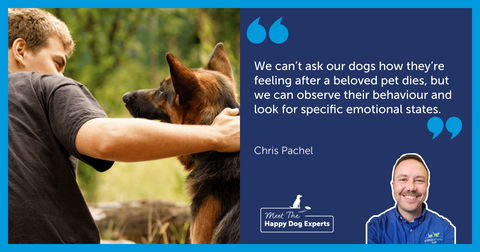Want to subscribe to our blog?
Did you know that it takes 3-4 weeks before a puppy starts to wag its tail (depending on their breed)?
After this time, their doggie instincts kick in and they start to wag their tail to communicate with their mother to let them know they are hungry; and theystart communicating with their siblings by wagging their tails - for example, to let them know they're in the mood to play!
Tails have other uses too! A dog also uses their tail for balance and to act as a rudder when they are swimming, or when they are on uneven ground. And when they are running or chasing, dogs use their tails to help them quickly turn direction - if you watch a dog when it is running, you will notice that their tail follows the direction of their front legs, acting as a counterbalance until their hind legs catch up.
Why do Dogs' Tails Wag?
A wagging tail can tell you so much about how your dog is feeling and, combined with other body language signs, is a great communication tool. In addition to this, different breeds of dogs have different sizes and shapes of tails, so it's not a case of one size fits all!
Let's explore why dogs wag their tails, and what the different tail movements and positions mean.
The neutral position
This may vary slightly from breed to breed. Some dog tails naturally hang down near their heels, but some (like curly tail breeds) may carry their tails higher. If your dog's tail wags in a broad, sweeping movement, this normally means your dog is feeling relaxed.
Wagging to the right
Thissuggests a positive emotion and normally means the dog is relaxed and happy - for example if they meet a person or other dog they recognise.
Wagging to the left
This can indicate a negative emotion, and mean that your dog may be feeling stressed.
Research has shown that dogs also recognise the direction of a tail wag in other dogs and understand their mood or emotion - and react accordingly. In one study, dogs watching the tail of a dog wagging to the right mostly stayed relaxed. However, when watching a dog's tail wagging to the left, they showed signs of increased anxiety.
The helicopter wag
If your dog is excited - for example when they meet someone they know, or another dog - their tail movement canwag in a circular motion, a little like a helicopter!
The wagging tail & body
Adding a wagging body to a wagging tail - and that means your dog issuper excited and wants to interact with you ! This is a good time to play with your pet!

A low, tucked in tail
This could indicate they are wary of a situation and nervous. They are letting others know that they mean no harm, but if the situation does not resolve itself then they may react adversely. Look for other body language signs that may indicate they are stressed and fearful - like lip-licking, yawning or trying to hide - and try to diffuse the situation to make them more relaxed.
Gentle wagging
If your dog is holding their taillevel with their body, and only gentle wagging,it could mean they are uncertain but curious - perhaps you have a new visitor to the housethat they have never met before.

Rapidly wagging from side to side
You will know that your dog is concentrating on something - like they are following a scent - if their tail is rapidly wagging from side to side.
A rigid vertical tail with a small wag
The high tail could mean that your dog is alert and something has caught their attention. There may be a narrow wag or even just the tip of the tail wagging, too. Their next move might be unpredictable. Try to understand why your dog is aroused (it could be they are excited or worried) and diffuse the situation if necessary by redirecting their attention and giving them space.
Rigid rather than relaxed wagging
If your dog is uncomfortable with a situation, their wagging tail might be rigid, rather than the wide, fluid wag of a relaxed dog.

Strengthening your Bond
A wagging tail means your dog is interacting but it is important that you take into account their body language and the surrounding situation to make sure you fully understand whether they are anxious, wanting to protect themselves or they are greeting you. The more you understand your dog, and can react to their wagging tail in the right way,the stronger your bond will be.
Using ADAPTIL in the home will help keep your dog calm in situations where they may feel stressed. It will help to strengthen your bond, by creating a reassuring environment at home, and provide constant comfort for your dog - leading to a lot of happy tail wagging!
Following our expert tips will help to ensure your bond with your dog goes from strength to strength.
Make sure to join our community for weekly advice from our dog behaviour experts as well as product offers and competitions.
 Related Posts
Related Posts

19 Ways to Comfort Your Dog in Stressful Situations

Dog Anxiety – 4 Things Every Owner Should Know

Happy Dog Expert: Help A Dog With Grief

Traveling With A Puppy In A Car
You consent to the processing of your personal data to receive our newsletters, you can unsubscribe at any time. To find out more about how your personal data is managed and to exercise your rights, please refer to the data privacy policy. Please visit this page.



































